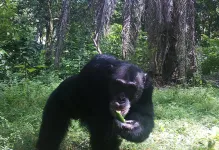INFORMATION:
The paper, published in the journal Scientific Reports, is entitled: "Chimpanzees balance resources and risk in an anthropogenic landscape of fear."
Chimpanzees and humans share overlapping territories
2021-02-25
(Press-News.org) Chimpanzees and humans "overlap" in their use of forests and even villages, new research shows.
Scientists used camera traps to track the movements of western chimpanzees - a critically endangered species - in Guinea-Bissau.
Chimpanzees used areas away from villages and agriculture more intensively, but entered land used by humans to get fruit - especially when wild fruits were scarce.
Researchers from the University of Exeter and Oxford Brookes University say the approach used in this study could help to inform a "coexistence strategy" for chimpanzees and humans.
"Understanding how wildlife balance the risks and rewards of entering environments used by humans is crucial to developing strategies to reduce risks of negative interactions, including disease transmission and aggression by animals or humans," said lead author Dr Elena Bersacola, of the Centre for Ecology and Conservation on Exeter's Penryn Campus in Cornwall.
"Using 12 months of data from 21 camera traps, our study produced hotspot maps that show how humans and chimpanzees overlap in their use of forests, villages and cultivated areas."
Chimpanzee use of space was linked to the availability of naturalised oil-palm fruit, and the study also shows that chimpanzees access high-risk orange, lime and papaya fruits in response to nutritional necessity rather than preference alone.
The study used a "landscape of fear" framework, based on the idea that animals learn about risks and the resulting fear shapes their decisions over where and when to feed, travel and rest.
Researchers are increasingly incorporating humans as agents for shaping the wildlife's landscapes of fear.
The team in this study were cautious not to let the chimpanzees become "habituated" (used to humans, and therefore not fearful).
"Elena got around this problem by setting up a patchwork of camera traps throughout one chimpanzee community's home range and monitoring their use of space," said Dr Kimberley Hockings, of the University of Exeter.
"The methods and analyses Elena used are new and exciting and have helped us understand human-chimpanzee coexistence across the landscape.
"This is important because western chimpanzees are critically endangered and these shared landscapes are crucial for their persistence.
"These methods can also be applied to other threatened wildlife that are being pushed into ever-increasing human-impacted landscapes across the globe."
Professor Catherine Hill, of Oxford Brookes University, said: "Our modelling approach generates fine-resolution space-time output maps, which can be scaled-up to identify human-wildlife interaction hotspots.
"Our method provides the necessary tools to understand and more effectively manage human-wildlife coexistence at different spatial scales, including the management of resources important to both."
ELSE PRESS RELEASES FROM THIS DATE:
Allergy season starts earlier each year due to climate change and pollen transport
2021-02-25
Allergy sufferers are no strangers to problems with pollen. But now - due to climate change - the pollen season is lasting longer and starting earlier than ever before, meaning more days of itchy eyes and runny noses. Warmer temperatures cause flowers to bloom earlier, while higher CO2 levels cause more pollen to be produced.
The effects of climate change on the pollen season have been studied at-length, and END ...
Study shows opioid use among US patients with knee osteoarthritis costs 14 billion dollars in societal costs
2021-02-25
Although guidelines do not recommend use of opioids to manage pain for individuals with knee osteoarthritis, a recent study published early online in END ...
On the line: Watching nanoparticles get in shape
2021-02-25
Liquid structures - liquid droplets that maintain a specific shape - are useful for a variety of applications, from food processing to cosmetics, medicine, and even petroleum extraction, but researchers have yet to tap into these exciting new materials' full potential because not much is known about how they form.
Now, a research team led by Berkeley Lab has captured real-time high-resolution videos of liquid structures taking shape as nanoparticle surfactants (NPSs) - soap-like particles just billionths of a meter in size - jam tightly together, ...
A-maze-ing pheasants have two ways of navigating
2021-02-25
Pheasants fall into two groups in terms of how they find their way around - and the different types prefer slightly different habitats, new research shows.
University of Exeter scientists tested whether individual pheasants used landmarks (allocentric) or their own position (egocentric) to learn the way through a maze.
The captive-bred pheasants were later released into the wild, and their choice of habitat was observed.
All pheasants favoured woodland, but allocentric navigators spent more time out in the open, where their landmark-based style is more useful.
"Humans tend to use both of these navigational tactics and quite frequently combine them, ...
CAR T-cell therapy generates lasting remissions in patients with multiple myeloma
2021-02-25
In a major advance in the treatment of multiple myeloma, a CAR T-cell therapy has generated deep, sustained remissions in patients who had relapsed from several previous therapies, an international clinical trial has found.
In a study posted online today by the New England Journal of Medicine, trial leaders report that almost 75% of the participants responded to the therapy, known as idecabtagene vicleucel (ide-cel), and one-third of them had a complete response, or disappearance of all signs of their cancer. These rates, and the duration of the responses, are significantly ...
Fantastic voyage: Nanobodies could help CRISPR turn genes on and off
2021-02-25
The genetic tool CRISPR has been likened to molecular scissors for its ability to snip out and replace genetic code within DNA.
But CRISPR has a capability that could make it useful beyond genetic repairs. "CRISPR can precisely locate specific genes," says Lacramioara Bintu, an assistant professor of bioengineering at Stanford. "What we did was attach CRISPR to nanobodies to help it perform specific actions when it reached the right spot on DNA."
Her lab recently used this combo technique to transform CRISPR from a gene-editing scissors into a nanoscale control agent that can toggle specific genes on and off, like a light switch, to start or stop the flow of some health-related protein inside a cell.
"There are a lot of things you can't fix ...
Baby mice have a skill that humans want - and this microchip might help us learn it
2021-02-25
Baby mice might be small, but they're tough, too.
For their first seven days of life, they have the special ability to regenerate damaged heart tissue.
Humans, on the other hand, aren't so lucky: any heart injuries we suffer could lead to permanent damage. But what if we could learn to repair our hearts, just like baby mice?
A team of researchers led by UNSW Sydney have developed a microchip that can help scientists study the regenerative potential of mice heart cells. This microchip - which combines microengineering with biomedicine - could help pave the way for new regenerative heart medicine research.
The study is featured on the cover ...
New discoveries on the containment of COVID-19 finds travel bans are of limited value
2021-02-25
BROOKLYN, New York, Wednesday, February 24, 2021 - Travel bans have been key to efforts by many countries to control the spread of COVID-19. But new research aimed at providing a decision support system to Italian policy makers, recently published in the Journal of the Royal Society Interface, suggests that reducing individual activity (i.e., social distancing, closure of non-essential business, etc.) is far superior in controlling the dissemination of Sars-CoV-2, the virus that causes COVID-19.
The research, which has implications for the United States and other countries, found that limiting personal mobility through travel restrictions and similar tactics is effective only in the first phases of the epidemic, and reduces in proportion to the ...
UM scientists achieve breakthrough in culturing corals and sea anemones cells
2021-02-25
MIAMI--Researchers have perfected the recipe for keeping sea anemone and coral cells alive in a petri dish for up to 12 days. The new study, led by scientists at the University of Miami (UM) Rosenstiel School of Marine and Atmospheric Science, has important applications to study everything from evolutionary biology to human health.
Cnidarians are emerging model organisms for cell and molecular biology research. Yet, successfully keeping their cells in a laboratory setting has proved challenging due to contamination from the many microorganisms that live within these marine organisms or because the whole tissue survive in a culture environment.
UM cell ...
New shape-changing 4D materials hold promise for morphodynamic tissue engineering
2021-02-25
New hydrogel-based materials that can change shape in response to psychological stimuli, such as water, could be the next generation of materials used to bioengineer tissues and organs, according to a team of researchers at the University of Illinois Chicago.
In a new paper published in the journal Advanced Functional Materials, the research team -- led by Eben Alsberg, the Richard and Loan Hill Professor of Biomedical Engineering -- that developed the substances show that the unique materials can curl into tubes in response to water, making the materials good candidates for bioengineering blood vessels or other tubular structures.
In nature, embryonic development and tissue healing often involve ...





